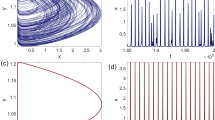Summary
Contractile actomyosin systems play a central role in the generation of intracellular patterns. Models for pattern formation have benefited greatly from the application of mechanochemical theory. However, investigations of the patterns have been primarily qualitative in nature; the two-dimensional nature of the evolving patterns has not yet been addressed mathematically, nor has the evolution of stable heterogeneous steady-state solutions. We consider these issues, supporting our analytical predictions with numerical simulations in one and two spatial dimensions. We show how, for certain gels, the two and three-dimensional tensor equation which describes a balance of forces can be reduced to a reaction-diffusion equation.
Similar content being viewed by others
References
Alberts, B., D. Bray, J. Lewis, M. Raff, K. Roberts, and J. D. Watson. 1983.Molecular Biology of the Cell. London: Garland Publishing.
Condeelis, J. 1983. “Rheological properties of cytoplasm: significance for the organization of spatial information and movement.” InModern Cell Biology, Vol. 2:Spatial Organization of Eucaryotic Cells, J. McIntosh (Ed.), pp. 225–240. New York: Alan R. Liss.
Landau, L. D., and E. M. Lifshitz. 1970.Theory of Elasticity, (2nd Ed.). London: Pergamon Press.
Landau, L. D., and E. M. Lifshitz. 1979.Fluid Mechanics. London: Pergamon Press.
Lewis, M. A. 1990.Analysis of Dynamic and Stationary Biological Pattern Formation. D. Phil. Thesis, University of Oxford.
Lur'e, A. I. 1964.Three-Dimensional Problems of the Theory of Elasticity, Ch. 1. New York: John Wiley.
Murray, J. D. 1989.Mathematical Biology. Heidelberg: Springer-Verlag.
Murray, J. D. and G. Oster 1984. “Generation of biological pattern and form.”J. Math. Appl. Med. Biol., 1, 51–75.
Oster, G. F. 1984. “On the crawling of cells.”J. Embryol. Exp. Morph.,83, 329–364.
Oster, G. F., J. D. Murray, and A. K. Harris. 1983. “Mechanical aspects of mesenchymal morphogenesis.”J. Embryol. Exp. Morph. 78, 83–125.
Oster, G. F., J. D. Murray, and G. M. Odell. 1985. “The formation of microvilli.” InMolecular Determinants of Animal Form, G. M. Edelman (Ed.), pp. 365–384. New York: Alan R. Liss.
Oster, G. F., and G. M. Odell. 1984a. “Mechanics of cytogels I: Oscillations inPhysarum.”Cell Motil., 4, 469–503.
Purcell, E. 1977. “Life at Low Reynolds Number.”Amer. J. Phys.,45, 1–11.
Taylor D., S. Hellewell, H. Virgin, and J. Heiple. 1979. “The solation-contraction coupling hypothesis of cell movements.” InCell Motility, S. Hatano (Ed.), pp. 363–377. Baltimore: University Park Press.
Author information
Authors and Affiliations
Additional information
Communicated by Stephen Wiggins
Rights and permissions
About this article
Cite this article
Lewis, M.A., Murray, J.D. Analysis of stable two-dimensional patterns in contractile cytogel. J Nonlinear Sci 1, 289–311 (1991). https://doi.org/10.1007/BF01238816
Received:
Accepted:
Issue Date:
DOI: https://doi.org/10.1007/BF01238816




